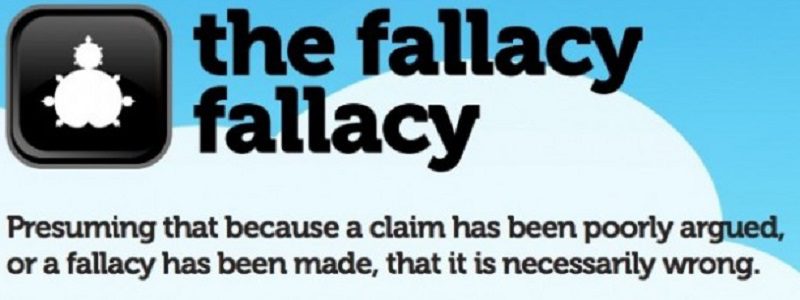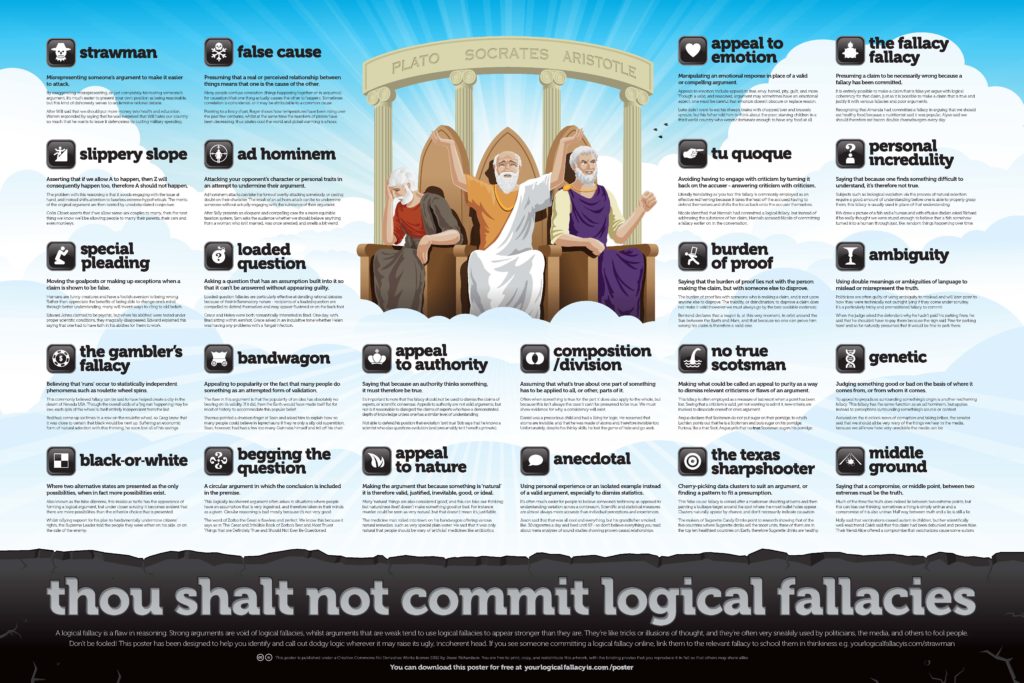
Logical Fallacies: Teaching Reasoning Skills by Examining Their Absence
Many, perhaps most, critical thinking and argumentation textbooks discourage teaching logical fallacies as a stand-alone unit. John Bean, for example, in his Engaging Ideas: A Professor’s Guide to Integrating Writing, Critical Thinking, and Active Learning in the Classroom (John Wiley & Sons, 2011), cautions that students will readily forget the names and definitions of logical fallacies when learned in the abstract, and that they are best learned when blended instruction focused on argumentation about specific content.
I’ve always been persuaded by this position and we recommend it in our work with middle and high school teachers. Acquire a facility with the various types of logical fallacy, and invoke them when most applicable in your regular argument-based instruction. Still, no pedagogical guideline like this should be viewed as an absolute rule, and recently we’ve come across a website that might help teachers elevate the place of logical fallacies in their effort to improve their students’ reasoning skills.
Yourlogicalfallacyis.com is the site of Australian marketing executive turned education innovator David McRaney. You can take a look at his TED Talk explaining the premises behind his interest in logical fallacies, critical thinking, and the future of education, here:

The website is quite simple and rather narrow in scope. It contains this wonderfully information-rich and useful poster of 24 distinct logical fallacies.

Backing up a step, opens with a plain and readily digestible definition of a logical fallacy.
A logical fallacy is a flaw in reasoning. Logical fallacies are like tricks or illusions of thought, and they’re often very sneakily used by politicians and the media to fool people. Don’t be fooled! This website has been designed to help you identify and call out dodgy logic wherever it may raise its ugly, incoherent head.
Each of the 24 fallacies has a page, linked to the fallacy icons on the home page, on which the fallacy is named, defined, described, and exampled.
The site as a whole has an informal, accessible, irreverent, but not flippant style, which (along with its lack of complexity or even much layering) adds to the ease of use for teachers and students. The examples are both illuminating and entertaining. The definitions and descriptions are clear and written with pedagogical utility in mind.
Teachers using argumentation extensively in their classrooms might find a place for the teaching of logical fallacies in a mini-unit, as a way of building students’ reasoning skills by looking at instances of their absence. They might then reference back to this unit when coming across both flawed and coherent instances of logical reasoning later at other times during the year. What activities and assessments might such a mini-unit include? Here are several possibilities.
Logical Fallacy Poster-Making
Have students work in pairs and assign them one of the 24 logical fallacies on yourlogicalfallacyis.com. Have them create a poster of the fallacy that can be put up in the classroom. The poster should have the title and definition of the fallacy. It can be designed creatively, but it must have a section for real-world examples (in print, online, or transcribed from other media).
Logical Fallacy Burdened Fake Writing
Have students write a short essay on an issue that you either have already studied or will study, or that is chosen specially for this assignment. Students should write an argument essay in which they can entirely make up their evidence – no research or reading required – and that has to include at least four separate logical fallacies in its reasoning. The fallacies should be identified in an addendum to the essay.
Find the Fallacy Activity
Screen a debate from the 2016 presidential election, or a set of advertisements from YouTube, or another similar video, and have students complete a graphic organizer in which they find as many different types of logical fallacies as possible. Be sure that you pre-find fallacies in the video material so that you know what students can and should find (though they may surprise you with their own findings!).
Logical Fallacy Testing
Provide students with 24 logical fallacies on an in-class assessment that they have to properly label and explain.
These are a few of the many ways that we can teach logical fallacies on their own, as a way to improve our students’ reasoning skills by giving them categories into which the absence of coherent and logical reasoning can be placed and understood. Whether you teach these apart from argument-based content instruction, or integrated with that teaching, or you blend both methods, logical fallacies are another tool in the argument-centered instructional toolkit.
If you try any of the above activities or assessments, let us know how it goes, or contact us for our support!

